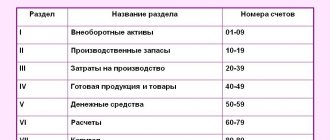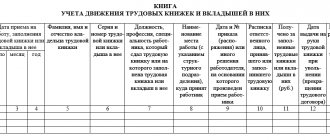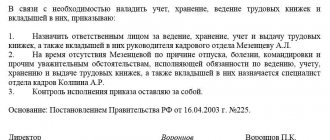New rules for filling out and maintaining work books
The Ministry of Labor published a draft departmental order updating the procedure:
- maintaining and storing work books;
- issuing a duplicate or the work book itself upon dismissal;
- issuance of documents when an employee submits an application for the employer to provide him with information about work in accordance with Article 66.1 of the Labor Code of the Russian Federation.
The order will put into effect updated instructions for maintaining a work book with comments and changes to the form. The document will become larger - for information about the work they propose to allocate 14 spreads, not 10. This is what the title page project looks like:
There are several main changes in the design procedure:
- Information about part-time work will be allowed to be entered both in chronological order and in blocks, i.e., immediately about admission and about dismissal.
- Entries will be allowed to be made not only by hand, but also using technical means: stamps (seals) that leave an impression or transfer dye.
- Employees will not have to sign when leaving.
It is stipulated that the employer is obliged to return the work book no later than 3 working days from the date of filing the application if he refuses to maintain a paper form.
Keeping records of completed work books (inserts) and empty forms will continue. Employers will be allowed to use independently developed forms of accounting books (journals).
Confused about the new rules on work books? Use the free guide from ConsultantPlus to do everything right. Experts have discussed how to now work with paper and electronic versions.
Accounting for books at the enterprise
The rules for storing work books provide for monitoring them. The following must be mandatory:
- book of accounting of inserts in work books and the books themselves;
- income and expense ledger for accounting forms.
Throughout the entire period of existence of the employment relationship between the employee and the employer, the relevant Instruction provides for the storage of work books directly with the employer.
At the enterprise, the accounting journal is stitched, certified with the employer’s signature and sealed. The accounting department of the organization in the expenditure and receipt book is obliged to keep records of the receipt and issuance of both work book forms and inserts for it, indicating the number and series of the issued or received form.
The personnel service records the employment or dismissal of an employee in the work book record book, as well as the work books and inserts for them with the number and series received from employees. Upon dismissal, each employee must sign not only on his personal card, but also in the company’s labor book.
Work books of employees at enterprises must be stored in appropriate, specially equipped places:
- in metal cabinets;
- metal safes;
- special rooms.
This requirement is mandatory since they are important documents of strict accountability. A specially appointed employee of the enterprise’s HR department is responsible for their safety, who reports monthly to the organization’s accounting department on the number of forms and the amount received for its registration or for labor forms, in writing. Damaged forms must be destroyed, but first a corresponding act must be drawn up and signed by the commission. Deliberate or negligent violation of the procedure for maintaining, recording and storing work books without appropriate conditions leads to liability directly from the head of the enterprise.
Where to buy a form
The employee does not need to purchase the form independently. The employer, in accordance with paragraph 44 of Government Decree No. 225 dated April 16, 2003, is obliged to constantly have the required number of forms and inserts available. When issuing the appropriate form, the employer charges the employee an appropriate fee, the amount of which is determined by the amount of costs for purchasing these forms, as established by paragraph 47 of Government Decree No. 225 dated April 16, 2003.
The legislative framework
The rules approved by Government Decree No. 225 dated April 16, 2003 explain and regulate the administration. They spell out general issues of the procedure for maintaining, storing, making changes, corrections, and issuing, including duplicate books.
The rules consist of eight sections:
- General provisions.
- Maintaining documents.
- Making changes and corrections. Duplicate work book.
- Issue upon dismissal.
- Insert.
- Accounting and storage.
- Responsibility for maintaining procedures.
- Production of forms and provision of them to employers.
The instructions approved by the Ministry of Labor on the procedure for filling out work books and inserts for them contain relevant instructions for each of the areas. The procedure for making entries in work books is established by Resolution of the Ministry of Labor dated October 10, 2003 No. 69, which contains seven sections.
General provisions
Entries should be made carefully, in black, blue or purple ink, without any abbreviations. For example, the surname, first name and patronymic must be written in full; writing a surname with initials is not allowed. Arabic numerals are used. Columns are filled in capital letters. There is only one exception: when the employee signs on the title page, he is allowed to write his full name in block letters to avoid confusion and possible questions.
Filling out employee information
When filling out the book for the first time, indicate the following information on the title page:
- surname, name, patronymic of the employee;
- full date of birth;
- information about the education received;
- specialist diploma (if available).
This is what a sample of filling out the title page of a work book looks like:
The section contains information on the basis of which documents and in what order information about the owner is entered, including when changes are made to personal data.
For example, changes in records of last name, first name and patronymic are made on the basis of a passport or other documents and with reference to their number and date. These changes are made on the first page (title page). The previous surname, first name or patronymic is crossed out with one line and new data is written down. Links to the relevant documents are made on the inside cover and certified by the signature of the employer or a specially authorized person and the seal of the organization (or the seal of the personnel service).
Filling out job information
In accordance with Article 66 of the Labor Code of the Russian Federation), the employer is obliged to keep records of work experience for each employee who has worked for more than five days, and when the work is the main one. The section describes the procedure and sequence for making entries about the function performed by the employee, about the assignment of ranks, classes or ranks.
For example, in column 3 of the “Work Information” section, the full name of the organization is indicated as a heading, as well as the abbreviated name of the organization (if available).
In the third column, a record is made of acceptance or appointment to a structural unit of the organization, indicating the specific name, position, specialty, profession, indicating qualifications, and in column 4 the date and number of the order (instruction) or other decision of the employer according to which the person was hired is entered. . Records of the name of a position, specialty, profession indicating qualifications are made, as a rule, in accordance with the organization’s staffing table.
If, in accordance with Federal laws, the performance of work in certain positions, specialties or professions is associated with the provision of benefits or the presence of restrictions, then the names of these positions, specialties or professions and the qualification requirements for them must correspond to the names and requirements provided for in the relevant qualification directories.
When applying for a job, the book is filled out in the following order:
- Column 1 - enter the serial number of the current record;
- Column 2 - the date from which the employee was hired;
- 3 columns - full and abbreviated name of the employing organization, exact name of the position according to the staffing table, qualifications;
- 4 columns - number and date of the order for enrollment.
Filling out information about the award
According to the instructions for filling out work books, this section contains information about the titles, diplomas, certificates and other awards assigned to the employee, provided for by the legislation of the Russian Federation and the internal regulations of the organization. The following are required to be entered:
- presentation of state awards;
- awarding diplomas, certificates, insignia;
- incentives prescribed in the Labor Code of the Russian Federation.
A corresponding entry indicating by whom, when and for what merits the employee was awarded is made in column 3 of the “Information on awards” section. The details of the base document are indicated in a special field.
Another type of award is “Gratitude”. It is entered into the document only if it is formalized by an appropriate order in the organization.
Filling out information about dismissal
Due to its importance and volume, the section contains not only detailed and specific explanations and rules for making entries about the reasons for termination of the owner’s contract. To do this, specific instructions are given for filling out work books 2021 with comments and examples. When a contract is terminated on the grounds provided for in Article 77 of the Labor Code of the Russian Federation (except for cases of termination of the contract at the initiative of the employer and due to circumstances beyond the control of the parties), a record of dismissal (termination of the employment contract) is made in the form with reference to the paragraph of this article. For example: “Dismissed by agreement of the parties, paragraph 1 of Article 77 of the Labor Code of the Russian Federation” or “Dismissed at his own request, paragraph 3 of Article 77 of the Labor Code of the Russian Federation.”
Features of filling out information about dismissal (termination of contract) and hiring (appointment) in connection with the transfer of an employee to another permanent job with another employer (to another organization) or his transfer to an elective job (position)
When an employee moves from one position to another, a corresponding note is made in the work book. It is important to note that the transfer is recognized as legal only if there is the consent of the employee himself.
There are two types of transfers from one position to another:
- internal - the employer remains the same;
- external - the contract with the current employer is terminated and a new employment contract is concluded.
Also, the transfer can be permanent or temporary - when replacing a temporarily absent employee. In this case, in the third column:
- when transferring externally, indicate the date and number of the order of dismissal from one organization (full name), the date and number of the order of enrollment in another organization (full name). Indication of positions is necessary in both cases;
- when transferring internally, it is written as follows: “transferred to position” indicating it, the name of the department, if necessary.
Features of filling out a duplicate
In fact, the provisions of this section are divided into two subparagraphs: filling out a duplicate with the previous employer and filling out a duplicate if the employee worked for another employer before joining the organization.
The guidelines contain the form of the receipt and expenditure book for recording the forms of the work book and the inserts in it and the form of the book of accounting for the movement of work books and the inserts in them.
Correcting errors and making changes to TC
Expert opinion
Kostenko Tamara Pavlovna
Lawyer with 10 years of experience. Author of numerous articles, teacher of Law
Those responsible for labor accounting can make mistakes, just like any employee. It must be borne in mind that if a typo is identified during the initial entry of data into the Labor Code, then the form must be immediately liquidated, drawing up an act of liquidation of the form, and creating a new document.
- If typos are found in the title form (in the full name, as well as in other personal information) after filling out the TC by other companies, you will have to file a lawsuit in order for the TC to be recognized as the applicant’s.
- When the level of education increases, it is necessary to make adjustments to the education data.
- If the employee has received a new specialty, a new entry is also entered.
- To correct the inscriptions in paragraphs 2 and 3, the old inscription is crossed out and a new one is entered based on the materials presented. At the same time, we note that strikethroughs are not allowed on the “Job Details” page. If, nevertheless, the inscription was made in error, then after it in the same column it is written that this inscription is invalid and the correct entry is filled in under a new serial number.
- If an error is detected with a new employer, the personnel employee draws up a record of the invalidity of the previous one, with a new record being made, with a new serial number, the date of correction and the corresponding order.
If the notice of dismissal is displayed incorrectly, there are two possible correction options.
- The first is that a new line about joining the company is entered, and the entry on termination of the contract is declared invalid.
- In the second option, it is written that the old inscription is invalid, and a new one is entered indicating the new reason for the break in relations.
A work book is an official document of an employee of an organization, which is issued by the employer. Data on the position held, transfers and other personnel movements are entered there, indicating the exact dates.
Instructions for filling out work books with examples
Where can I find samples of labor records? All options are in the instructions for filling out work books, approved by Resolution of the Ministry of Labor dated October 10, 2003 No. 69.
Sample entry in the labor document for translation
Sample entry in the employment record upon dismissal
An example of a job entry with the job function “landscaping” specified as a specific type of work
An example of an entry when applying for a job in the HR department for the position of HR specialist in a branch of the organization
Option 1, when the branch is indicated in the job description.
Option 2, the name of the branch is indicated in the name of the organization.
An example of a record of appointment (election) as a general director
Sample 1. Only the minutes of the meeting are indicated as the document on the basis of which the hiring takes place.
Sample 2. The minutes of the meeting and the order are indicated as the document on the basis of which the hiring takes place.
Responsibility for errors
As in any activity, errors when filling out the cover pages of work books lead to negative consequences. Their suppression is carried out using the following sanctions measures:
- Officials in case of a primary violation of the rules for filling out work books are liable in the amount of 5 to 50 minimum wages, and in case of a secondary violation they are disqualified for 1-3 years.
- For the first violation, legal entities are fined 300-500 minimum wages, and in the event of a repeat violation they may be completely suspended from their activities.
This is also important to know:
Dismissal of the chief accountant
All penalties from the above entities are carried out by the Labor Inspectorate.
What if a part-time worker is fired from his main job?
From the point of view of legislation, any entry is made at the main place of business; this provision cannot be circumvented.
External part-time work, according to Articles 60.1 and 282 of the Labor Code of the Russian Federation, is the performance of other regularly paid work under the terms of an employment contract in free time from the main job. does not oblige the employer to check whether the external part-time worker has a main place of work, nor does it oblige him to change the terms of the contract when the external part-time worker is dismissed from the main place of business. According to the norms of Article 72 of the Labor Code of the Russian Federation, changes to the terms of the contract determined by the parties are allowed only by agreement of the parties.
Thus, if the employer does not want to hire an external part-time worker for the main job, the entry will be made only after the external part-time worker gets a job in another permanent position.
If the employer decided to change the terms of the contract for an external part-time worker and signed a contract with him at the main place of work, the entry is made as usual.
Insert design
If all blank pages of the work are completed, the subsequent information is entered on the insert form. It is sewn into the end of the document. And on the title page of the main book a stamp is placed indicating the issue of the insert, indicating its number and series. The cost of the insert is paid by the employee. The rules for filling out are the same as for the main labor document:
- The insert is filled out by the employer.
- The date is stamped on the title page.
- Up-to-date information concerning the worker is added.
- The entry is certified by the personal signature of the person completing it and a seal.
Filling out the title page
The initial page is required to display all information about the accepted identity, based on the materials provided. All inscriptions are entered without abbreviations.
- Full name of the owner.
- Date of birth.
- Availability of education.
- Name of specialty according to diploma.
- TC registration date.
- Owner's signature.
- Signature of the personnel officer who filled out the document.
- Seal of the institution.
Sample of filling out the title page in 2021.
For a more complete study of this topic, you can watch the video.
How to fill out a document in different cases: samples
There are five basic rules for filling out the TC:
- All entries must be completed in legible handwriting.
- The inscription on the form is in the official language of the country.
- The inscriptions are made in blue or black ink, or in extreme cases, violet.
- Numbers are written only in Arabic.
- Errors, cross-outs, erases and other blots are prohibited.








